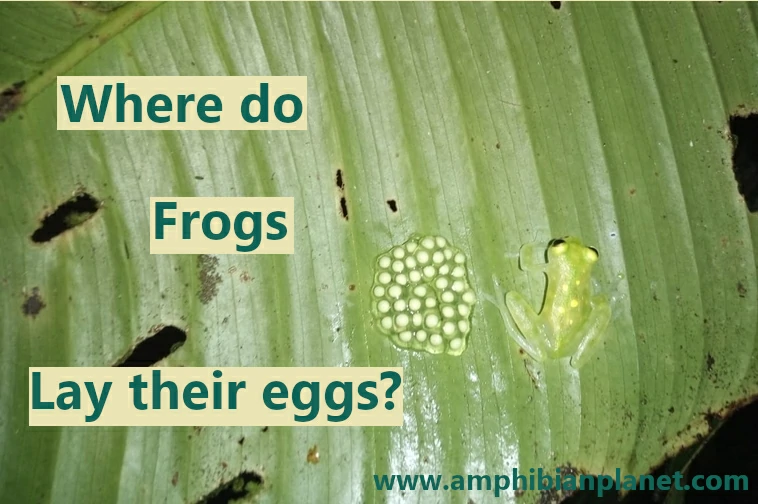There are over 7,000 frog species around the world – found in a wide variety of habitats, from rainforests to mountainous areas, to dry regions. Different frog species have adapted to their environments and developed breeding methods that are practical for the areas they live in.
Most frogs lay their eggs in shallow, fish-free freshwater bodies and attach them to vegetation near the water’s surface. Some frog species can lay their eggs in brackish water. Other frog species lay their eggs on leaves hanging over water bodies, in foam nests, and in puddles in bromeliad plants.
There are also frog species that lay their eggs away from the water -which could be on the leaves of terrestrial plants, in damp leaf litter, in moist soil, in caves, in rock crevices, and under logs and other objects on the ground.
A few frog species such as the Common coquí and even known to lay their eggs in abandoned bird nests.
Most Frogs Lay Their Eggs in Shallow, Freshwater Bodies
Most frogs lay their eggs in shallow, standing, or slow-moving freshwater bodies that are free of predatory fish.
This could be in woodland ponds, reservoirs, seasonal pools, river margins, lake edges, river backwaters, bogs, marshes, swamps, temporary rain puddles, and even in roadside ditches, deep tire tracks, or potholes filled with rainwater.
Some frog species such as the American green tree frog (Hyla cinerea) occasionally lay their eggs in water bodies with fish.
Other frog species such as the Coastal Tailed Frog (Ascaphus truei), and the waterfall frog (Ranoidea nannotis) lay their eggs in fast-flowing streams, and attach them underneath large rocks.
Since these frogs lay their eggs in fast-flowing water, their tadpoles have very strong tails for swimming, and mouths on the underside of their bodies. They use their large sucker-like mouth parts to cling onto rocks so they do not get washed away.
Many frogs species, such as the wood frog (Lithobates sylvaticus), spring peeper (Pseudacris crucifer), and the pacific tree frog (Pseudacris regilla), prefer to breed in something called “vernal pools“.

Vernal pools are temporal pools of water that form in the spring. They are formed when depressions on the ground are filled with water from melting snow and falling rain.
They are typically small and shallow, and unlike a pond or lake, they have no permanent source of water. This means they dry up in the summer.
Since they are temporal, they do not have fish that could eat the eggs before they hatch. This makes them ideal breeding sites for many amphibians.
Below Is a Table That Shows the Type of Water Bodies Where 22 Frog Species Will Lay Their Eggs In:
Frog Species |
Scientific Name |
Where They Lay Their Eggs |
| Wood frog | Lithobates sylvaticus | Vernal pools, woodland ponds, bogs roadside ditches, unused canals, and backwaters of streams |
| Pickerel Frog | Lithobates palustris | Sphagnum bogs, slow-moving streams, woodland ponds, wet meadows, and marshes |
| Northern Leopard Frog | Lithobates pipiens | Springs, beaver ponds, woodland ponds, and marshy edges and side channels of streams, rivers, or lakes |
| American bullfrog | Lithobates catesbeianus | Small, isolated wetlands, and along the vegetated edges of permanent bodies of water such as ponds, lakes, canals, and ditches |
| Green frog | Rana clamitans | Shallow, vegetated shorelines of lakes and permanent wetlands such as ponds, bogs, fens, marshes, swamps, and streams |
| Gray tree frog | Hyla versicolor | Marshes, bogs, swamp edges, woodland ponds, and flooded ditches |
| Spring peeper | Pseudacris crucifer | Small woodland ponds, larger swamps, vernal pools, flooded ditches, wet meadows, and Carolina Bays |
| African bullfrog | Pyxicephalus adspersus | Shallow, temporary water bodies, such as pools, pans, and ditches |
| American green tree frog | Hyla cinerea | Marshes, bayheads, cypress domes, sloughs, swamps, ponds, lakes, and ditches |
| Crawfish frog | Lithobates areolatus | Temporary ponds, roadside ditches, and flooded pastures – often with numerous crayfish burrows |
| Cuban tree frog | Osteopilus septentrionalis | Floodplain forests, swamps, cypress domes, marshes, wet flatwoods, ponds, and ditches |
| Coastal tailed frog | Ascaphus truei | Cold, clear, fast-flowing, rocky streams with little aquatic vegetation. The streams are usually in mature forests with a dense canopy |
| Carpenter frog | Rana virgatipes | Cypress ponds, interdunal swales, and tupelo-gum swamps |
| Northern red-legged frog | Rana aurora | Permanent or temporary wetlands, ponds, the margins of lakes, or slow-moving streams |
| Northern cricket frog | Acris crepitans | Ponds, small lakes, slow-moving streams, and river backwaters |
| Foothill yellow-legged frog | Rana boylii | Near the margin of slow-moving streams |
| Pacific tree frog | Pseudacris regilla | Ponds, ditches, marshes, slow moving steams, and shallow sections of lakes |
| Oregon spotted frog | Rana pretiosa | Shallow edges of wetlands where the water is warm and there is abundant emergent vegetation |
| Western chorus frog | Pseudacris triseriata | Shallow, temporary wetlands, such as sinkhole ponds, cypress domes, wet flatwoods, and flooded ditches and fields |
| European common frog | Rana temporaria | Well-vegetated, shaded, shallow ponds |
| Australian green tree frog | Litoria caerulea | Permanent pools, small temporary ponds, flooded ditches, and swamps |
| African clawed frog | Xenopus laevis | Warm, stagnant pools and quiet streams |
Many Frogs Are Not Picky About Their Aquatic Breeding Sites
Many frog species are not too picky about the water bodies they lay their eggs in. As long as they are deep enough and free of predatory fish, they are good enough to lay eggs in.
They will lay their eggs in virtually any small standing body of water.
Cuban tree frogs are known to lay their eggs in wetlands, ponds, ditches, drainage systems, water tanks, and even in swimming pools. Their eggs have also been found in old ice chests, children’s wading pools, and buckets half full of rainwater.
Pacific tree frogs are also known to use almost any type of still or slow-flowing water for breeding.
Boreal chorus frogs are also known to lay their eggs almost anywhere there is standing water – including in flooded potholes.
Some Frogs Can Lay Their Eggs in Brackish Water
Frogs have highly permeable skin and egg membranes. For this reason, they typically depend on fresh water and will avoid saline or brackish water.
High salinity levels can be very highly dangerous, or even lethal to most frogs. This is because salt tends to disrupt the water and ionic exchange across the permeable skin.
Frogs are generally most vulnerable to salt in the embryo stage and experience very low survival rates in salt environments.
Since tadpoles usually can not change their habitats, adult frogs select adequately diluted water bodies to lay their eggs, so the tadpoles can develop unharmed.
However, a few amphibian species can adapt to and tolerate saltwater habitats, especially those that live along the coast.
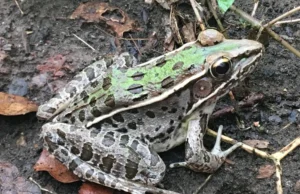
Frog species known to sometimes lay their eggs in brackish water include the following:
- Lowland Leopard Frog (Lithobates yavapaiensis)
- Southern Leopard Frog (Rana sphenocephala)
- Crab-eating frog (Fejervarya cancrivora)
- Pacific Treefrog (Pseudacris regilla)
- Asian grass frog (Fejervarya limnocharis)
- Chinese bullfrog (Hoplobatrachus rugulosus)
- Ornate chorus frog (Microhyla fissipes)
- African Clawed Frog (Xenopus laevis)
- Mediterranean painted frog (Discoglossus pictus)
These frogs live in coastal areas which get flooded by seawater, so they developed tolerance to brackish water as a survival strategy.
They lay their eggs in shallow water in lagoons, salt marshes, mangrove swamps, brackish ponds, tidal pools, tidal streams, and estuaries.
Some Frogs Lay Their Egg Leaves Hanging Over Water Bodies
Some frogs such as the red-eyed tree frog, and glass frogs of South America, do not lay their directly eggs in water. Rather, they lay them on leaves that hang over the water. When the eggs are ready to hatch, the tadpoles inside start wriggling around, breaking the eggs open.

The tadpoles then wash down the leaf and fall into the pond below.
Laying eggs this way protects them from lots of predators, both and land and in the water. In glass frogs, the male will remain with eggs to guard them from predators until they hatch.
Frog species that lay eggs on leaves hanging over water bodies include the following:
- Red-eyed tree frog (Agalychnis callidryas)
- Glass frogs (Centrolenidae)
- Blue-sided leaf frog (Agalychnis annae)
- Mexican leaf frog (Agalychnis dacnicolor)
- Waxy monkey tree frog (Phyllomedusa sauvagii)
- Antioquia leaf frog (Agalychnis danieli)
- Morelet’s tree frog (Agalychnis moreletii)
- Parachuting red-eyed leaf frog (Agalychnis saltator)
- Gliding tree frog (Agalychnis spurrell)
- White-lined leaf frog (Phyllomedusa vaillantii)
Frogs such as the red-eyed tree frog will lay their eggs directly on an exposed leaf, but others such as the Waxy monkey tree frog – fold their eggs into the leaf, to conceal them from predators.
Some Frogs Lay Their Eggs in Foam Nests
Some frogs such as the gray foam-nest tree frog of southern Africa and the Fourlined tree frog of Southeast Asia lay their eggs in a foam “nest”. This nest is built on branches or leaves overhanging a pond.

During the mating process, the female frogs produce an oviduct secretion. This secretion is then whipped up by the female, and the attending male’s hind legs to create a froth in which the eggs are laid and fertilized. The froth dries with a meringue-like crust to protect the eggs.
After a few days to a few weeks, depending on the species, the eggs will hatch and tiny tadpoles will wriggle down the foamy secretion and pop into the water below.
A few species such as the Túngara frog (Engystomops pustulosus) and the Colorado dwarf frog (Engystomops coloradorum) build their foam nests directly in the water, rather in trees.
When the tadpoles hatch, they develop in the water until they undergo metamorphosis and transform into juvenile frogs.
Other frogs species that lay their eggs in foam nests include the following:
- Peters’ dwarf frog (Engystomops petersi)
- Keller’s foam-nest frog (Chiromantis kelleri)
- African foam-nest tree frog (Chiromantis rufescens)
- Guayaquil dwarf frog (Engystomops pustulatus)
Some Tree Frogs Lay Their Eggs in Water Puddles in Trees
Some tree frogs such as the bromeliad tree frog or Amazon milk frog lay their eggs in puddles that collect in the holes of trees, or water-holding plants such as bromeliad plants, the leaf sheaths of banana leaves, and other water-filled crevices in the canopy.
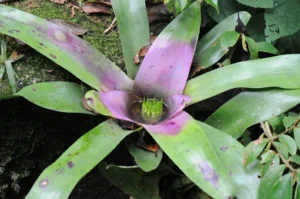
These pools of water provide a safe location away from most predators and competitors that are present in water bodies on the ground.
The tadpoles will usually complete their development in these small pools, where they eat algae and detritus, such as dead insects that fall into the water.
Below Is a Table That Shows Where 10 Tree Frog Species That Breed in Plant Cavities Will Lay Their Eggs:
Tree Frog Frog Species |
Scientific Name |
Where They Lay Their Eggs |
| Amazon milk frog | Trachycephalus resinifictrix | Tree hollows or bromeliads |
| Paranapiacaba tree frog | Bokermannohyla astartea | Bromeliads |
| Bromeliad tree frog | Bromeliohyla bromeliacia | Bromeliads |
| Bruno’s casque-headed frog | Nyctimantis brunoi | Bromeliads |
| Bokermann’s casque-headed frog | Trachycephalus atlas | Bromeliads |
| Bahia’s broad-snout casque-headed tree frog | Nyctimantis arapapa | Bromeliads |
| Surinam golden-eyed tree frog | Trachycephalus coriaceus | Tree hollows or bromeliads |
| New River tree frog | Trachycephalus hadroceps | Tree hollows or bromeliads |
| Rio golden-eyed tree frog | Trachycephalus imitatrix | Tree hollows or bromeliads |
| Veined tree frog | Trachycephalus typhonius | Tree hollows or bromeliads |
Some Frogs Lay Their Eggs on Land
Many frog species evolved to live in environments with low availability of undisturbed surface water suitable for tadpoles to live in. For this reason, they developed reproductive behavior that skips the tadpole stage altogether.
These frogs lay eggs in protected terrestrial environments, which then hatch into young frogs which are morphologically similar to the adults. This is known as ‘direct development.’
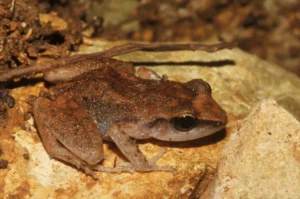
Depending on the species, the eggs are laid on leaves, in tree hollows, in caves, under logs, in damp soil or leaf litter, and even in abandoned bird nests.
As a general rule, frog eggs require moisture to develop and hatch successfully.
For this reason, frogs that lay their eggs away from the water usually lay them in damp locations, or provide moisture for the eggs by brooding them.
In many species, the males or females (or both) will remain with the eggs to guard them from predators.
Below Is a Table That Shows Where 12 Direct-Developing Frog Species Will Lay Their Eggs:
Frog Species |
Scientific Name |
Where They Lay Their Eggs |
| Common coquí | Eleutherodactylus coqui | In tree holes, on the leaves of terrestrial trees or plants, and in abandoned bird nests |
| Red-eyed coqui | Eleutherodactylus antillensis | In damp leaf litter or soil |
| Bush squeaker | Arthroleptis wahlbergii | In damp leaf litter |
| Common squeaker | Arthroleptis stenodactylus | In hollows or burrows in damp soil |
| Rio Grande chirping frog | Eleutherodactylus cystignathoides | In damp soil |
| Variable bush frog | Raorchestes akroparallagi | On the upper side of large leaves |
| Counou robber frog | Eleutherodactylus counouspeus | In caves |
| Mozart’s frog | Eleutherodactylus amadeus | Under logs, rocks, and other objects on the ground |
| N/A | Leptodactylodon ovatus | In holes and cracks in rocks |
| Cusco Andes frog | Bryophryne cophites | In nests of moss |
| Grand Cafe robber frog | Eleutherodactylus pinchoni | In damp soil, or in bromeliads |
| Neiba whistling frog | Eleutherodactylus parabates | In damp soil |
The eggs of direct-developing frogs are usually extra large because they have a lot of yolk to compensate for the lack of feeding as a tadpole.
The yolk will remain attached to the intestine to nourish the froglets for the first few days after hatching, in a sequence similar to chickens.
Such reproductive behavior allows these frogs to live in forests, mountains, and even in urban areas – without the limitation of a direct dependency on water.
A Few Frog Species Carry Their Eggs on Their Backs
With over 7,000 species of frogs and toads in the world, there are bound to be a few that stick out as being weird.
Here are a few frogs with weird breeding behavior.
1. Horned Marsupial Frog (Gastrotheca cornuta)
Horned marsupial frogs are found in Colombia, Costa Rica, Ecuador, and Panama. These frogs breed by direct development, which means they do not have a free-living tadpole stage.
The female frog releases eggs from her body, which the male then fertilizes, and deposits in a pouch on the female’s back.
She then carries the eggs around – which hatch as fully-developed frogs.
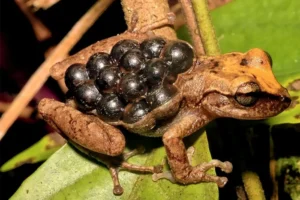
2. Banded Horned Tree Frog (Hemiphractus fasciatus)
Like the horned marsupial tree frog, the eggs of Banded horned tree frogs are carried in a pouch on the mother’s back and hatch into fully developed frogs.

Banded horned tree frogs are found in northwestern Ecuador.
3. Surinam Toad (Pipa pipa)
Surinam Toads are a fully aquatic frog species from the northern Amazon basin of South America. These frogs are unique, in that the female gives “birth” to the young out of her back!
The female releases about 100 eggs during mating. Next, the male fertilizes the eggs and pushes them into the female’s back – and the skin of the female then encloses the eggs.
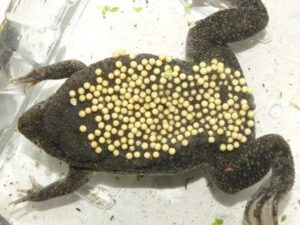
The embryos will develop to the tadpole stage inside of their egg pockets but will remain until they complete their development and become toadlets in about three to four months.
Once the eggs hatch, fully formed toads will pop out of the female’s back
Not All Frogs Lay Eggs
While most frogs reproduce by laying eggs, there are some exceptions. A few frog species such as the Broad-headed rainfrog (Craugastor laticeps) or Sulawesi Wart Frog (Limnonectes larvaepartus ), do not lay eggs at all – instead, they give ‘birth’ to live young.
When these frogs mate, their eggs are fertilized internally and are retained within a uterus formed of fused portions of the oviducts.
The developing embryos are nourished by the egg yolks, and after a few weeks, the female will give ‘birth’ to tiny, fully metamorphosed froglets, or tadpoles in the case of the Sulawesi Wart Frog. This is known as “Ovoviviparity.”
Common Questions About Frog Reproduction:
Do All Frogs Lay Eggs in Water? Most frogs lay their eggs in water, but some frog species will lay eggs on plants or in foam nests that hang over water bodies. Other frog species such as the common coqui lay their eggs in protected terrestrial environments away from the water.
Do Frogs Lay Eggs on Land? Most frogs lay their eggs in the water, but some frogs such as the Rio Grande chirping frog lay their eggs in moist soil on land. Other frog species that lay their eggs on land include the Red-eyed coqui, Bush squeaker, Counou robber frog, and the Neiba whistling frog.
Do Frogs Lay Eggs or Give Live Birth? Most frogs reproduce by laying eggs. However, some frog species retain the eggs inside their bodies until they are ready to hatch, and then give birth to miniature frogs which are morphologically similar to the adults – in a sequence known as “Ovoviviparity.”
Photo credit: Javier David Quiroga Nova (CC BY-NC 4.0)
Sources:
Hua, J. & Pierce, B.A. (2013) Lethal and sublethal effects of salinity on three common Texas amphibians. Copeia, 2013 (3): 562-566.
Chang, Y.-M & Wu, Chi-Shiun & Huang, Y.-S & Sung, S.-M & Hwang, W. (2016). Occurrence and reproduction of anurans in brackish water in a coastal windbreak forest in Taiwan. Herpetology Notes. 9. 291-295.
Gareth R. Hopkins and Edmund D. Brodie “Occurrence of Amphibians in Saline Habitats: A Review and Evolutionary Perspective,” Herpetological Monographs 29(1), 1-27, (1 December 2015). https://doi.org/10.1655/HERPMONOGRAPHS-D-14-00006
Janaina da Costa de Noronha & Domingos de Jesus Rodrigues (2018) Reproductive behavior of the glass frog Hyalinobatrachium cappellei (Anura: Centrolenidae) in the Southern Amazon, Journal of Natural History,
52:3-4,207-224, DOI: 10.1080/00222933.2017.1414324
Elinson, Richard. (2001). Direct development: An alternative way to make a frog. Genesis (New York, N.Y. : 2000). 29. 91-5. 10.1002/1526-968X(200102)29:23.0.CO;2-6.

